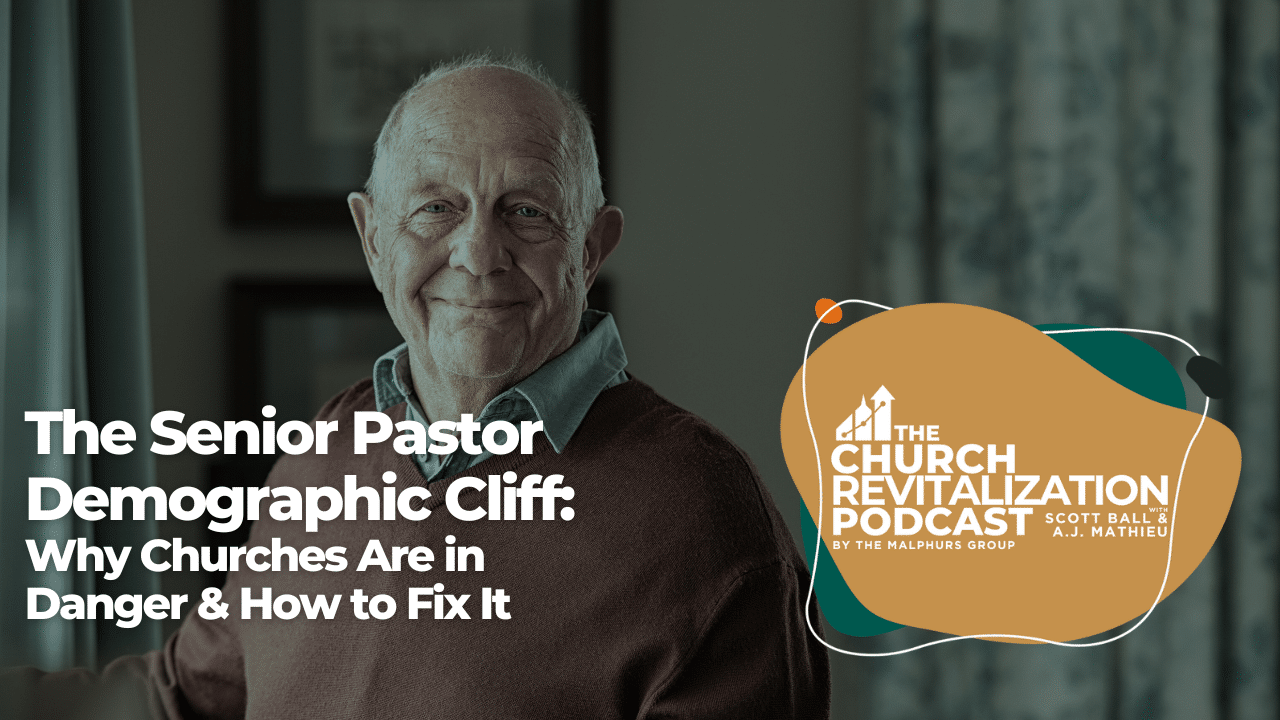The church in North America is hurtling towards a demographic cliff, and too few congregations are noticing the coming catastrophe. Not only are America’s pastors aging out of the ministry, but there are too few pastors-in-training to take their place. It’s not hyperbolic to assume that thousands of churches will be stuck in long-term pastor searches or, more likely, close or merge with other churches. In fact, these trends are already emerging. But it’s my conviction that it’s not too late to course-correct and avoid the coming disaster.
In order for change to occur, we must first fully understand the scope of the core problems: the aging pastorate and the lack of newly trained pastors. Then, we must explore the key solutions that can turn the tide and ensure that the United States doesn’t fall into the same trap that has already befallen Europe–and, to a lesser extent, Canada.
The solutions are within our grasp if only church leaders at the congregational and institutional levels link arms, put aside personal gain, reject the tyranny of the urgent, and commit to solving this problem. Below, we’ll expose the extent of the problem and propose practical solutions for developing more and better senior leaders to replace those who are aging out.
The Aging Out Problem
Research indicates a marked aging of pastors over recent decades, with implications for church leadership and ministry.
Barna Group’s study highlights the dramatic shift in the demographic profile of pastors since the 1990s, noting an increase in the average age from 44 to 54 years old over 25 years. This shift reflects broader societal trends, such as increased life expectancy and the economic impacts on retirement planning, but also points to a decrease in younger individuals entering pastoral ministry. The research underscores the challenge of identifying and training future leaders, as two-thirds of current pastors find it difficult to find suitable candidates for ministry.
Lifeway Research further corroborates this trend, showing the average clergy age as 57, up from 50 in 2000. This increase is partly due to clergy postponing retirement and a decrease in young adults enrolling in seminaries. The trend towards older congregations and leaders is expected to continue, complicating efforts to rejuvenate and revitalize churches.
The Lewis Center for Church Leadership offers additional insights. Their study corroborates the overall trend, noting that the overall percentage of lead pastors in evangelical congregations that are 54 or younger has dropped from 61% to 41% since 1998. But they also suggest that while the overall aging of the U.S. population partly explains the aging clergy, it doesn’t fully account for the low proportion of younger clergy. This discrepancy raises concerns about the church’s ability to connect with younger generations and adapt to changing cultural dynamics. The Center suggests that exploring other factors contributing to this disparity and developing strategies to attract and retain younger clergy are crucial steps for addressing the leadership gap.
The Seminary Problem
Seminary education, which is the centerpiece of most senior pastor job descriptions, is increasingly out-of-reach for young leaders. To say it bluntly, the system is stacked against young leaders hoping to go to seminary, even if they do sense a call into vocational ministry. Seminary leaders, recognizing that their own institutions are at risk, have mostly adapted by expanding their programs beyond the scope of training pastors in order to survive financially.
The landscape of seminary education and enrollment is evolving, with notable trends in the types of programs attracting students and the career paths they pursue post-graduation. According to recent data, North America’s 280 Christian seminaries enrolled 78,000 students in fall 2022, showing a slight decline overall with specific decreases among evangelical (-3.2%) and mainline Protestant (-5.9%) schools, while Roman Catholic and Orthodox schools saw a small increase (2.6%). The appeal of online seminary classes has remained strong, especially as the variety of Master’s degree options continues to expand, drawing in a more diverse and older student body. This shift reflects a broader trend away from traditional pastoral ministry toward a wider range of ministry fields.
In terms of specific programs, there has been a significant shift in seminary education towards degrees outside of the traditional M.Div. path, such as counseling and administration. This shift indicates a broadening of the scope of seminary education to include roles beyond the altar and pulpit, which has been a contributing factor to the overall increase in seminary enrollment over the past ten years. Despite a dramatic decline in the number of seminarians taking the traditional path into pastoral ministry, there’s been growth in enrollment for evangelical seminaries. This diversification in seminary education reflects a changing religious landscape, where ministry roles are expanding beyond the church into broader (and sometimes higher-paying) societal contexts.
Furthermore, the Association of Theological Schools (ATS) reports that seminaries are offering over 200 different degrees, catering to a wide range of interests and career goals. This includes fields like Aging and Spirituality, Apologetics & Cosmogony, and even Sports Chaplaincy at Liberty University’s John W. Rawlings School of Divinity, among others. The expansion of M.A. degree programs and the introduction of new, specialized fields of study are seen as growth opportunities for seminaries to attract new students. These trends suggest that seminaries are adapting to meet the needs and interests of a changing student demographic looking for diverse career paths in and out of traditional church settings.
The shifts in seminary education towards a broader range of programs and away from traditional pastoral training present a complex scenario for seminaries and their primary stakeholders, namely the churches that require well-trained pastors for their congregations. On one hand, the diversification in seminary offerings, including increased enrollment in programs like counseling, administration, and specialized ministry fields, helps seminaries to attract a wider student body and remain financially viable in a changing educational and religious landscape.
On the other hand, this shift can create tensions with churches looking for seminary graduates trained in pastoral ministry to lead congregations. Churches depend on seminaries to provide the next generation of pastoral leaders who are well-versed in theology, scripture, and the pastoral skills necessary for church leadership. The decline in students pursuing traditional pastoral paths and the broadening focus of seminary programs can lead to a potential mismatch between the supply of pastorally trained graduates and the demand from churches.
The Problem of Financial Disincentives
The financial misalignment between the cost of obtaining a Master of Divinity (M.Div.) degree, the time investment required, and the relatively low compensation for pastoral positions creates significant disincentives for potential seminary students. This financial barrier is not only a challenge for those discerning a call to pastoral ministry but also reflects broader economic pressures within the church and theological education sectors.
The average cost for a bachelor’s degree for state residents adds up to around $115,352 over four years. Adding the cost for an M.Div, which could approximate $35,058 to $86,094 over three years depending on living expenses, illustrates a significant financial undertaking. This considerable investment, juxtaposed with the modest salaries often offered for pastoral positions, underscores the financial hurdles facing those pursuing ministry.
The average salary of a newly minted pastor can vary significantly based on factors such as the specific state, city, size of the congregation, and denomination. However, a general reference point for senior pastors across the United States suggests an average salary of $68,218 in 2024, with a range typically from $38,000 to $107,000. This includes base salary, bonuses, and possibly other forms of compensation like housing allowances, which are common in pastoral compensation packages. We could assume that a younger leader with less experience may, optimistically, skew closer to the average than toward the top end of the range.
The M.Div. program, often seen as the gold standard for pastoral training, requires a substantial investment of time and resources from students. These programs are rigorous and comprehensive, designed to prepare students for the multifaceted responsibilities of pastoral leadership. However, the return on investment, at least in financial terms, can be discouraging when considering the modest salaries often offered by churches for pastoral positions. This economic reality can deter individuals from pursuing pastoral ministry despite a genuine call or interest in serving the church in this capacity.
The vast majority of young leaders are not interested in going into the ministry to get rich. But they have normal, even noble, aspirations of leading and loving their families well. The disincentive of carrying tens of thousands of dollars in seminary debt, plus undergraduate debt, the cost of owning a home, purchasing a vehicle, and affording groceries on a $60,000 per year salary is hardly a symptom of greed. It’s a recognition of reality.
Ultimately, addressing the financial disincentives in pastoral ministry and education is a central factor in solving the demographic problem and requires a collaborative effort among seminaries, churches, denominational bodies, and the broader Christian community. By working together, these entities can help ensure that financial barriers do not hinder the calling and preparation of future pastors, who play a crucial role in the life and mission of the church.
Practical Solutions
The demographic trends and financial pressures on seminary students, if left unaddressed, do indeed pose a significant threat to the future of many churches, particularly in the United States and Canada. As the number of pastors decreases due to retirement and attrition, and fewer individuals are able or willing to take on the financial burden of seminary education for lower-paying pastoral positions, churches may find themselves without the leadership necessary to thrive.
Seminary Education Financing:
This includes increasing scholarship opportunities, exploring more affordable models of theological education, and providing financial literacy and debt management resources for seminary students. Seminaries could also work towards more sustainable funding models that can lower tuition costs.
Church and Denominational Support:
Churches and denominations could increase support for seminary students, both financially and through mentoring and internships that provide valuable experience and a clearer path to pastoral roles. Additionally, reevaluating compensation and benefits for pastors to reflect the investment they’ve made in their education and to ensure they can serve without undue financial stress is crucial.
Innovative Ministry Models:
Exploring and embracing diverse models of pastoral ministry, including bi-vocational roles, could make ministry more financially sustainable for individuals. This approach recognizes the evolving nature of ministry in today’s world and the diverse skills pastors bring to their congregations and communities.
Advocacy and Awareness:
Raising awareness about the financial realities of pastoral ministry is essential. By advocating for better support systems and resources for those in ministry, the broader Christian community can help ensure that financial barriers do not prevent talented, called individuals from entering pastoral roles.
Addressing these issues within the next decade is critical to averting the demographic cliff and ensuring that churches across the United States and Canada can continue to serve their communities effectively. By taking proactive steps now, the Christian community can support the next generation of pastors and church leaders, ensuring that they are equipped, supported, and financially able to fulfill their callings.
Watch this episode on YouTube!


Scott Ball is the Vice President and a Lead Guide with The Malphurs Group. He lives in East Tennessee with his wife and two children. (Email Scott).

